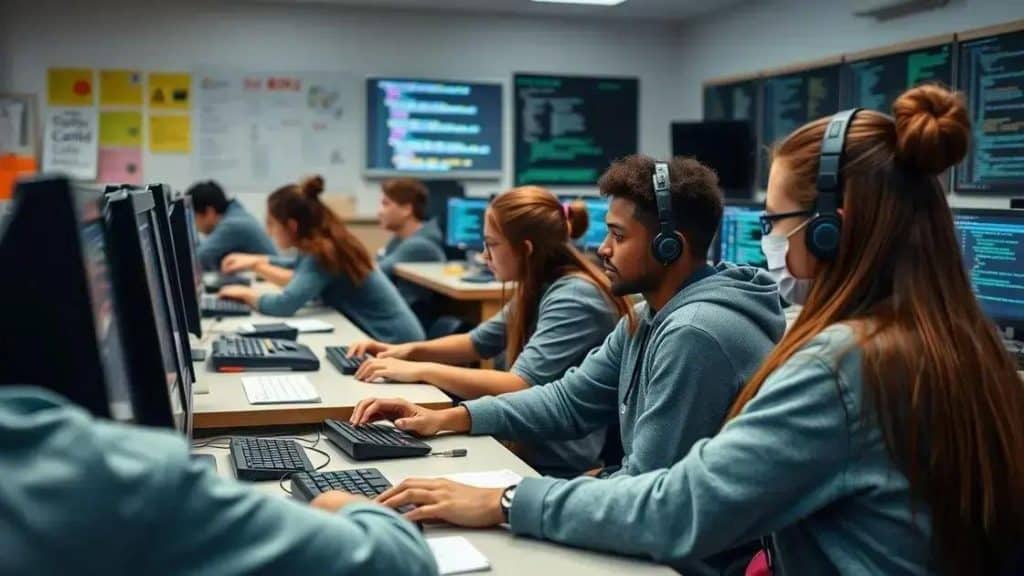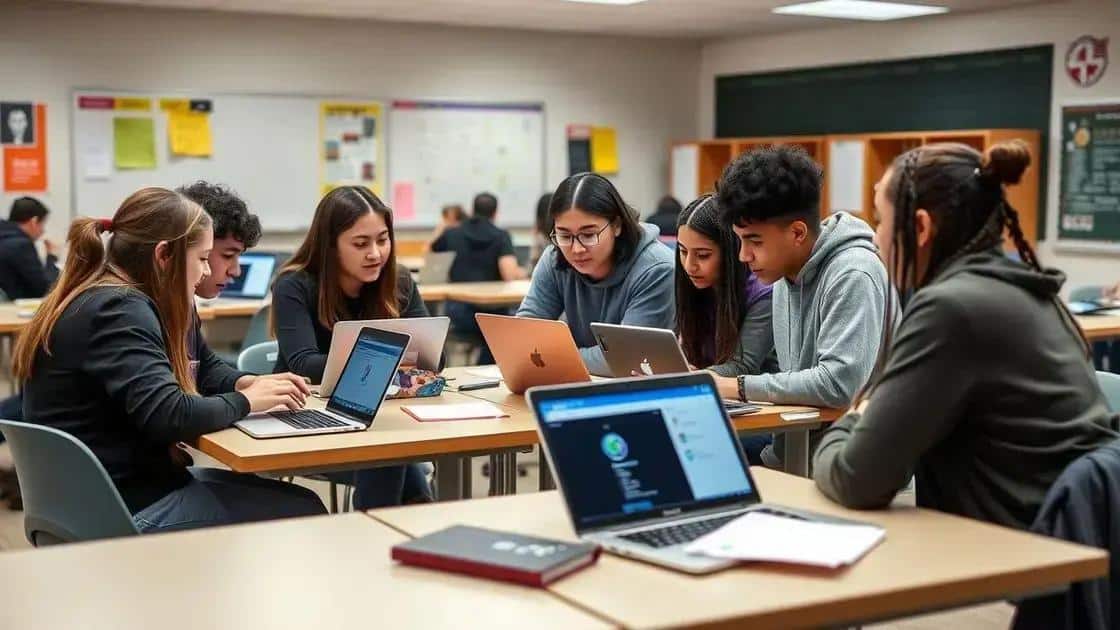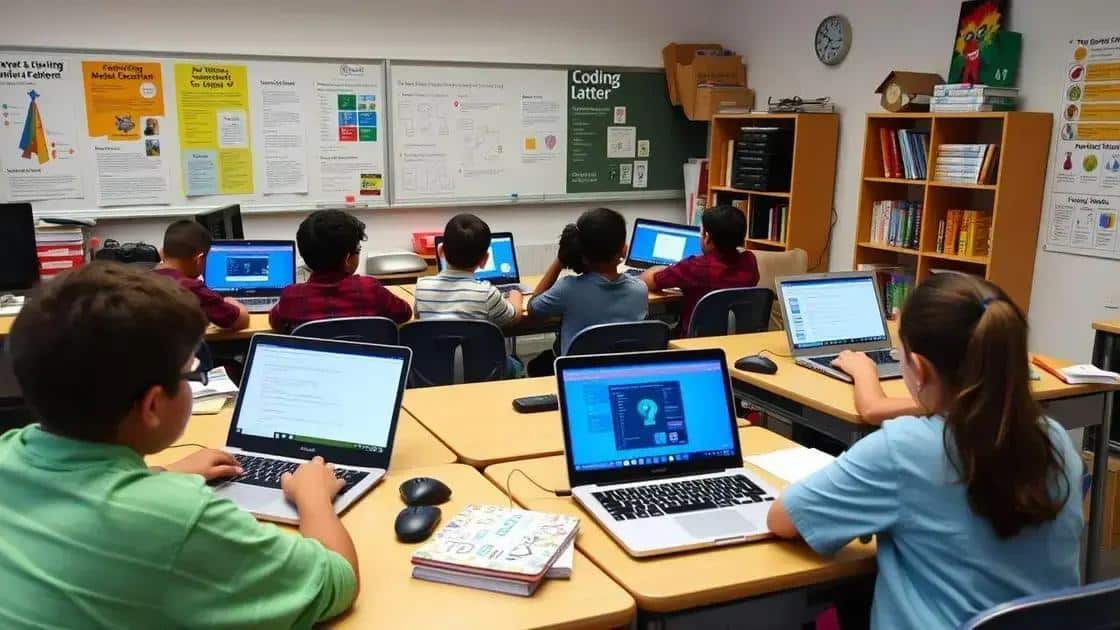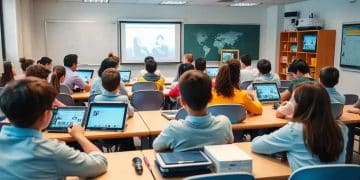Insights on high school coding classes that inspire creativity

Coding classes in high schools enhance students’ critical thinking, creativity, and collaboration skills, preparing them for future careers by utilizing effective tools and resources in engaging learning environments.
Insights on high school coding classes reveal their growing importance in modern education. Have you ever wondered how these classes shape problem-solvers and innovators? Let’s dive into what makes coding education so significant.
Why coding classes are essential in high schools
Coding classes are becoming increasingly vital in high schools. They not only teach technical skills but also encourage creativity and problem-solving. As technology plays a significant role in our lives, understanding coding can open many doors for students in their future careers.
Benefits of Coding Classes
Incorporating coding into the curriculum provides students with important benefits that they can use both academically and personally. Here are a few advantages:
- Enhances problem-solving skills.
- Encourages logical thinking.
- Fosters teamwork and collaboration.
- Prepares students for future job opportunities.
Additionally, exposure to coding helps students develop a growth mindset. By tackling challenging projects, they learn to persevere through difficulties and adapt to new information. This adaptability is crucial in an ever-changing job market.
Coding as a Creative Outlet
Coding isn’t just about numbers and algorithms; it’s also an art form. Students can bring their ideas to life by creating games, websites, and apps. This creative aspect makes learning to code exciting and engaging. As they see their projects come to fruition, they gain confidence in their abilities.
Moreover, coding classes can bridge the gap between technology and creativity. Students learn that coding is not only a skill set but a powerful tool for expressing their thoughts and visions. This duality encourages a diverse approach to learning.
Preparing for the Future
In today’s technology-driven world, knowing how to code is becoming increasingly essential. Many jobs now require at least a basic understanding of coding languages. By taking coding classes in high school, students equip themselves with skills that will be beneficial in various career paths.
As we move towards a more digital future, the demand for skilled coders will only increase. Early exposure to coding allows students to gauge their interest in technology-related fields. This exploration can lead to informed decisions about their future studies and careers.
In summary, the integration of coding classes in high schools significantly contributes to students’ educational journeys. They offer a unique blend of critical thinking, creativity, and future-readiness that is invaluable in the modern world.
Skills students gain from coding programs

Students who participate in coding programs acquire valuable skills that extend beyond just programming. These skills contribute to their overall development and prepare them for future challenges. Each aspect of coding introduces new ways to think, collaborate, and tackle problems.
Critical Thinking and Problem Solving
Coding nurtures critical thinking skills as students learn to break down complex problems into smaller, manageable parts. It encourages them to approach challenges with a logical and systematic mindset. As they work through coding assignments, students develop their ability to find solutions efficiently.
- Analyze problems methodically.
- Test and revise solutions.
- Develop algorithms for effective problem-solving.
- Make decisions based on logical reasoning.
This thought process isn’t limited to coding; it applies to many other subjects and real-life situations. Students become adept at navigating challenges in various aspects of their lives.
Collaboration and Communication
In coding classes, students often work in teams, which enhances their collaboration and communication skills. Working on group projects requires them to share ideas, discuss approaches, and provide feedback to one another. These interactions foster a supportive learning environment.
Effective communication is essential in tech fields, especially when working on projects with diverse teams. Learning to express ideas clearly prepares students for collaborative work in their future careers.
Alongside collaboration, coding often incorporates peer reviews, where students critique each other’s code. This process teaches them how to give and receive constructive feedback, a crucial skill in any career.
Creativity and Innovation
Coding is not merely about writing lines of code; it also stimulates creativity and innovation. As students create their own programs, games, or websites, they express their individuality and ideas. They learn how to imagine a project and bring it to life through code.
Moreover, the freedom to experiment leads to unexpected discoveries and innovative solutions. This encourages students to think outside the box and push their boundaries, which is vital for personal growth and future endeavors.
Through coding programs, students gain a well-rounded set of skills that prepare them for academic and professional success. These skills encompass critical thinking, teamwork, creativity, and problem-solving abilities, all of which are essential in today’s rapidly evolving world.
How coding influences creativity in students
Coding significantly influences creativity in students by providing them with a unique platform to express their ideas. When students learn to code, they unlock their potential to create projects that reflect their personal interests and passions. This freedom encourages them to experiment and innovate in their work.
Creating Personalized Projects
Through coding, students can develop personal projects that resonate with their experiences. They can create games, websites, or applications that embody their unique perspectives. This ability to tailor projects fosters a sense of ownership and pride in their creations.
- Freedom to explore different formats and ideas.
- Ability to express individuality through design.
- Opportunities to tell stories via interactive media.
- Developing unique solutions to problems they care about.
As they code, students learn how their creative choices affect the functionality of their projects. This hands-on learning process encourages them to think outside traditional boundaries.
Problem-Solving as a Creative Process
When faced with obstacles in coding, students must find creative ways to solve problems. This process often involves brainstorming multiple solutions, experimenting with different approaches, and learning from failures. By viewing challenges as opportunities for creativity, students develop resilience.
This problem-solving aspect of coding promotes a mindset where students see creativity as a key component of engineering and technology. They begin to understand that innovative ideas often stem from overcoming difficulties.
Collaboration Sparks New Ideas
Coding projects often involve teamwork, where students collaborate to share ideas. These interactions spark creativity through diverse perspectives. When students brainstorm together, they inspire one another, which leads to more creative solutions.
Working in groups can also help refine their ideas. Students learn to listen to each other’s suggestions, which can lead to unexpected and innovative outcomes. By discussing and critiquing each other’s work, they enhance their creative thinking skills.
Ultimately, coding not only equips students with technical skills but also significantly boosts their creative capacities. As technology continues to evolve, fostering creativity through coding becomes essential in preparing students for future challenges.
Tools and resources for effective coding classes

Having the right tools and resources is essential for running effective coding classes. These resources not only facilitate the learning process but also make coding more engaging for students. By utilizing various tools, educators can create a more interactive and productive learning environment.
Essential Coding Platforms
Several platforms are designed specifically for teaching coding, offering user-friendly interfaces and comprehensive learning paths. Here are some popular options:
- Code.org – Offers a variety of coding courses tailored for students of all ages.
- Scratch – A visual programming language that helps beginners learn coding concepts through interactive projects.
- Codecademy – Provides hands-on coding lessons in various languages, including Python and JavaScript.
- Replit – An online coding environment that allows students to write and test code in real time.
These platforms provide essential features like step-by-step tutorials, project-based learning, and community support, making them valuable resources for both teachers and students.
Hardware and Software Requirements
To facilitate effective coding classes, schools should invest in appropriate hardware and software. This includes reliable computers or tablets that can run coding software and tools efficiently. Additionally, ensuring that students have access to:
- Development environments suitable for their projects.
- Code editors like Visual Studio Code or Atom for advanced coding tasks.
- Access to online forums and communities where they can seek help.
Proper hardware ensures that students can experiment freely without technical difficulties, enhancing their learning experience.
Supplementary Learning Resources
Besides platforms and tools, supplementary learning resources can significantly enhance coding education. Teachers can use online resources such as tutorials, videos, and forums to support their lessons. Websites like:
- Khan Academy – Offers video tutorials on programming.
- YouTube – A vast repository of coding lessons and live coding sessions.
- GitHub – A platform for sharing and collaborating on code, which can provide real-world examples and practical experience.
These resources not only aid in the understanding of complex concepts but also encourage collaboration and exploration among students.
Using a combination of tools, software, and supplementary resources creates a rich learning environment where students can thrive in their coding classes. The right mix of technology and creativity can inspire them to continue learning and growing.
FAQ – Frequently Asked Questions about High School Coding Classes
What skills do students learn in coding classes?
Students learn critical thinking, problem-solving, collaboration, and creativity through hands-on coding projects.
How do coding classes enhance creativity?
Coding allows students to express their ideas through personalized projects, fostering innovation and creative problem-solving.
What tools are recommended for effective coding classes?
Recommended tools include platforms like Code.org, Scratch, and Replit, which provide interactive and user-friendly coding environments.
How can coding education prepare students for future careers?
Coding education equips students with essential technical skills and a growth mindset, making them ready for various career opportunities in a digital world.





